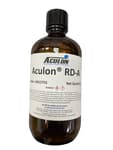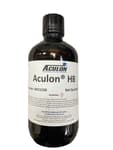Repellency Treatments
Repellency treatments are a category of products designed to protect various surfaces from both water and oil-based liquids. These treatments create a non-stick barrier that repels liquids, preventing stains and other forms of damage. Metal and glass surfaces, as well as those made from sapphire or other materials, are often exposed to both water and oil-based liquids. Repellency treatments that are both hydrophobic and oleophobic can help prevent damage caused by these substances, ensuring that surfaces remain clean and free of stains.
In addition to protecting against water and oil-based liquids, repellency treatments with hydrophobic and oleophobic properties can also resist other types of contaminants, such as dirt, dust, and grime. This can be particularly useful in industrial and commercial settings, where surfaces are exposed to a wide range of substances.
Aculon's repellency treatment technology bonds with many different surfaces at the nano-scale to create easy-clean, superhydrophobic (water-repelling) and oleophobic (oil repelling), anti-smudge coatings. These coatings are currently being used on metals, polymers, glass, and many other materials for numerous applications
Metal Repellency Treatment
- Renders metal surfaces hydrophobic/oleophobic
- 2-4 nm thickness
- Repellent to nearly any liquid
- 6 weeks
Glass Repellency Treatment
- For making glass surfaces hydrophobic and oleophobic
- 2-20 nm thickness
- Easy to apply, optically clear and ultra thin
- 6 weeks
Multi Surface Hydrophobic Treatment
- General purpose hydrophobic treatment
- 20-100 nm thickness
- Repels most aqueous liquids
- 6 weeks
Multi Surface Oleophobic Treatment
- General purpose hydrophobic/oleophobic treatment
- 30 - 300 nm thickness
- Reduces surface friction
- No longer available
AcuWet ON-470 Hydrophilic coating
- Provides a hydrophilic coating
- Excellent chemical bonding to many surfaces
- Easy to apply
- 6 weeks
EC Nanoscale Epoxy control
- Eliminating Die Attach Epoxy bleed
- Epoxy control in Semiconductor packaging
- Excellent chemical bonding to many surfaces
- 6 weeks
RD-A primer | Isopropanol solvent
- Provides basic protection for accidental water damage
- Coating Thickness 5-100 nm
- For coatings that react with metal alkoxide functional groups
- 6 weeks
Aculon HB | Hydrophilic Treatment
- Used as provided for wipe applications
- Use for dip treatment applications
- Gentle enough for many substrates.
- 6 weeks
Product Selector Guide
| Product | Solids(%) | Solvent | Specific gravity | Thickness (um) | Viscosity (cP) | Boiling point ° | Flash Point ° | Transmission (%) | Water Contact angle ° |
|---|---|---|---|---|---|---|---|---|---|
| Metal Repellency Treatment | 5 | Ethanol, Fluorosolvent | 0.98 | 2 - 4 | 2 | 78 | 13.9 | 100 | 116 |
| Glass Repellency Treatment | 10 | Fluorosolvent | 1.6 | 2 - 20 | 2 | 129 | N/A | 90 | 115 |
| Multi Hydrophobic Treatment | 10 | Hydrocarbon | 0.75 | 20 - 100 | 1 | 93 - 104 | -10 | 100 | 110 |
| Multi Oleophobic Treatment | 10 | Hydrocarbon, Fluorosolvent | 1.12 | 30 - 300 | 2 | 62 | -10.5 | 100 | 115 |
| RD-A Primer | 5 | Isopropanol | 0.8 | 5-100 | 2 | 82 | 12 | 100 | - |
| HB - Hydroph | - | Water | 1.1 | - | - | - | - | - | - |
Thickness depends on the amount of Solids. The higher the amount of solids, the thicker the coating after the solvent evaporates.
Frequently Asked Questions
Frequently Asked Questions about Superhydrophobic Treatments
Clients often find the word "superhydrophobic" and then ask if our products will meet their requirements. The answer is that this would depend on what your expectations are for performance and durability. From our experience, we don\'t think it is a fit to our technology, but before we decide that, let me ask you some questions that will help us get to that point. Then we can determine for ourselves.
What are the substrates under consideration?
This is critical to understand what tech options are available to consider. For surfaces such as porcelain, there is not an oxide containing surface, so you need a method to apply a durable treatment and then we are limited to short lifetime options due to this. Most often, customers do not want to reapply on a daily/weekly basis.
What are functional properties and performance expectations?
This is critical to determining if there is a technology in our portfolio of products. If customers want a super hydrophobic (150°+), it can be applied but it is not an easy application for very large surfaces (reapplication needed would be tedious and frequent). Also any superhydrophobic that can be applied (including competitive materials we are aware of as well) is extremely fragile and sensitive, usually only acceptable for one-time use applications or where frequent re-application is acceptable. Often times people say "superhydrophobic" but a regular hydrophobic of 120° will meet the need when permanency is needed, so we try to gather clarification on what is really required.
What are the durability requirements, expected lifetime, and any other technical merits?
Customers often want a certain level of durability in the magnitude of months, years, or possibly the life of the product. Even for hydrophobic applications on an oxide surface where we can apply a more robust coating, flooring is just a poor application due to the level of aggressive abrasion and wear seen. Also for outdoor applications a majority of our treatments are UV sensitive and quickly break down in sunlight. So again an important consideration.
What materials will the treated part come in contact with?
Details here give us an idea of how long the coating can be reasonably expected to last.
Do you have a mandatory process parameter requirement?
Spray, dip, wipe, printing. Answers to this question helps to focus in on options when multiple routes are feasible.
How soon do you require a solution for implementation?
This helps us to determine urgency, and also how soon we can expect to see a return on our time investment.
What is the annual volume expectation for this treated part?
Is this a commercial or research project? It is good to gather whether this is for a one-off project, or for a company in production.
Has a budget been allocated for this project?
This helps us to understand if they have funds for qualification/optimization work
What is your price expectation for the treatment on a per-unit basis?
Applications that are typically low value, with high expectations often fall outside our core competencies which rather focus on applications that have a high value to the proposed solution
Learn More
What we can't do for you
While our Repellency treatments are great for their application fields there are some common misunderstandings for Superhydropobics that we would like to address
Superhydrophobic (WCA 150°+) durability
We can not offer this in general for any application. Any superhydrophobic we have is essentially one time use with regards to durability. The real question is "Is really a superhydrophobic needed or a hydrophobic will do"?
Hydrophobic additive
We only have hydrophobic surface treatments. We do not have any formulary additives for making a formulation (coating, adhesive, asphalt, etc) hydrophobic. Our only additives are for adhesion applications. We can only serve you if surface treatment after the fact is possible.
Outdoor applications
Our hydrophobic treatments are predominantly UV sensitive and would not survive the UV exposure for long. On the same note if there\'s a lot of contact and abrasion it is unlikely that our treatments will meet long lifetime expectations.
I want to waterproof my camera lid. What\'s the best solution?
- Hydrophobic options (from Aculon or others) which are optically clear and durable are not repellent enough (max WCA 120°). Water droplets will still remain & result in undesired blurry optical performance.
- Superhydrophobic options (from Aculon or others) which fully shed water (150°+) rely on some level of surface roughening as such are hazy and not optically clear. They also have awful durability on the order of hours to days.











